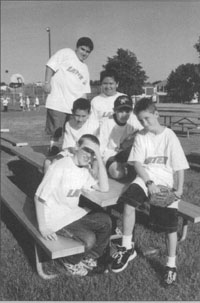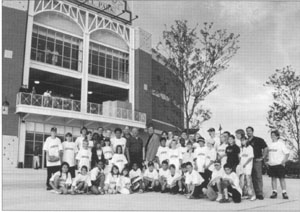 |
Home | Search | Browse | About IPO | Staff | Links |
 |
Home | Search | Browse | About IPO | Staff | Links |
|
Partnerships PARK DISTRICTS, FOREST PRESERVES AND RECREATION DEPARTMENTS WORKING TOGETHER WITH CIVIC AND BUSINESS LEADERS TO BUILD OUR COMMUNITIES LATER Is Better for Kids in Schaumburg Funded by a $45,000 grant from Cook County, an at-risk youth program is a success in Schaumburg thanks to cooperation from many local governments BY Ann Ziolkowski, PLP  Schaumburg’s successful LATER program targets youth ages 11 to 14 in specific neighborhoods It’s a hot summer night in June. The police department receives a phone call regarding a dozen or so unruly teens at a local park. Within minutes, the officers arrive on the scene. The youths have already fled the site, leaving their mark of vandalism behind: spray paint on playground equipment, picnic tables broken into pieces, and scattered litter from the overturned garbage cans. These are minor offenses, perhaps, but they are increasingly familiar throughout urban, suburban and rural parks. Often such incidents lead to more serious crimes and gang problems. In an effort to provide positive recreational experiences at local parks, the Schaumburg Park District and the Schaumburg Police Department offered a pilot program during the summer of 1999, targeting at-risk youth in specific community neighborhoods. Called the “LATER” program (Lending A Hand to Youth Through Education and Recreation), it provided various activities for Schaumburg teens, ages 11 to 14, at two Schaumburg parks. Designed as a “drop in” program, LATER was available at both parks from 5:30 p.m. until 9:30 p.m., Monday through Friday, starting in mid-June and ending in late-August. Friday nights were designated as Special Event/Trip Nights and featured trips to the Schaumburg Flyers baseball games, local attractions, and downtown Chicago venues. The average attendance at each park was 40 participants per night with the participants from both sites coming together on Friday trips. Not surprisingly, many of the youths stated early on that they generally did not participate in park district recreation programs. However, by mid-summer, a large percentage of these same participants were coming back, night after night. From the onset, LATER was a cooperative effort between various community agencies including school cistricts 54 and 211, the Schaumburg Township District Library, the Schaumburg YMCA, the Village of Schaumburg, and the Schaumburg Park District. Each agency participated in the planning and development of the program. According to Mary Beth Thaman, superintendent of recreation at Schaumburg Park District, the LATER program “successfully demonstrated the commitment of these agencies to the community. This is an excellent example of all of us working together to create positive change in Schaumburg.” The two parks selected, Roberts and Brandenburg, were identified by the Schaumburg Police Department as neighborhood parks that have experienced crime, drug activity, and an increase in gang association by junior high youths. LATER was designed to address these problems by involving the youth from these neighborhoods in an educational and socially constructive evening program. In a final evaluation sent to the park district, a LATER parent wrote: “This park was a safe haven for the children. This was the most wonderful community service. Children met and interacted with members of the police and fire departments and developed a new-found respect for them.” The funding for LATER was derived from a Cook County grant that provided monies for programming alternatives to gang and drug involvement. The $45,000 grant was secured by the Schaumburg Police Department requiring specific documentation before, during and after the program. The money 10 | Illinois Parks and Recreation | May / June 2000 was used for staffing, trip admissions, transportation, supplies and equipment.  Benefits Based Programming BBP measures a program’s success not only on attendance and revenue, but on the benefits realized by individuals, communities and society as a whole. A successful BBP incorporates three factors, previously identified as lacking or missing, which inhibit participation in structured activities. The three factors are Resiliency, Risk, and Protective. BBP was implemented in the initial planning stages of the LATER program. Monitoring and evaluating various components of the program became integral to its success. Specific risk factors impacting youth in these neighborhoods included issues of alienation, family history of abuse, alcoholism, and stress. For LATER, the known Protective factors identified were lack of knowledge of neighborhood resources, ineffective use of leisure time, and almost no presence of role models. Having this information in advance, LATER programming focused on enhancing certain skills or Resiliency factors. These included building relationships, encouraging a sense of independence, taping into creativity, and taking the initiative to get involved. The program focused on different themes each night which link to the Resiliency, Risk, and Protective Factors. Activities were designed with specific goals in mind. For instance, an evening activity such as dodge-ball, focused on conflict resolution, personal achievement, teamwork, and partnering with adults in the community (firefighters, police officers, etc.). Rick Hanetho, division manager of programs at Schaumburg Park District, was equally impressed with the effective result of the BBP model. “I would encourage other recreation departments and agencies to implement the BBP tool to enhance the credibility of their leisure programs,” says Hanetho. “Utilizing this measurement tool and having actual data to rely on will greatly increase our chances of further community involvement, parental support, and grant opportunities.” Says Thaman: “I think it’s significant any time you can measure changed behavior of participants, especially in a ten-week program. We actually made an impact on their social behavior skills.” Thaman shares a success story told by one of the LATER police officers: “Back in June, several male youths exhibited signs of antisocial and non-participative behavior. By the end of August, these youths, with the assistance of police staff at the park, had signed up for the Freshmen football at their high school.” A routine geographic crime analysis by the Schaumburg Police Department provided an additional accolade for the LATER program. The analysis showed a sharp drop in minor offenses in both geographic areas where the parks are located. The northern area experienced a 41 percent reduction during the summer and the southern area had a 30 percent drop. In addition, both neighborhoods show a significant decrease in calls for police service in June, July and August.
Participants Rate
Schaumburg’s LATER Program The Schaumburg Park District and Schaumburg Police Department are extremely encouraged with the results of this pilot program. Both agencies are committed to continuing the program for the summer 2000 and will seek opportunities to expand its scope. Parents are eagerly anticipating this summer’s program and the opportunity for their children to spend constructive time at the local parks. To that, the teens say...LATER! Ann Ziolkowski, PLP Photo: Village president Al Larson and park district commissoiner Mike Daniels, with LATER participants and staff from the Schaumburg Park District, fire deparment and police department pose during the LATER field trip to a Schaumburg Flyers ballgame last season. 11 | Illinois Parks and Recreation | May / June 2000 |
|
Sam S. Manivong, Illinois Periodicals Online Coordinator |